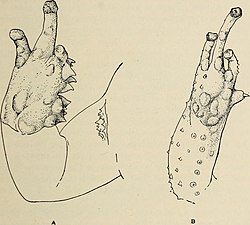Biology:Hoplophryne
| Hoplophryne | |
|---|---|
| Scientific classification | |
| Domain: | Eukaryota |
| Kingdom: | Animalia |
| Phylum: | Chordata |
| Class: | Amphibia |
| Order: | Anura |
| Family: | Microhylidae |
| Subfamily: | Hoplophryninae |
| Genus: | Hoplophryne Barbour and Loveridge, 1928[1] |
| Type species | |
| Hoplophryne uluguruensis Barbour and Loveridge, 1928
| |
| Species | |
|
2 species (see text) | |
Hoplophryne is a genus of microhylid frogs.[2][3][4] The genus is endemic to mountain forests of Tanzania.[2][4] They are also known as three-fingered frogs[2][4] or African banana frogs[2] (not to be confused with Afrixalus, another African genus known as "banana frogs"[5]).
Species
There are two species in this genus,[2][3][4] both endangered:[6]
- Hoplophryne rogersi Barbour and Loveridge, 1928
- Hoplophryne uluguruensis Barbour and Loveridge, 1928
Description
Hoplophryne are small frogs, reaching 32 mm (1.3 in) in snout–vent length (female H. rogersi).[4] Their distinctive characters is that male frogs have only three fingers: the thumb is reduced to a small bump or group of spines.[1][4]
Ecology and reproduction
Hoplophryne can be found in leaf litter,[4] under logs, and in bananas and bamboos.[1] Reproduction takes place in phytotelmata. The modified thumbs of males are probably involved in mating, helping the male to embrace the female.[1]
References
- ↑ 1.0 1.1 1.2 1.3 Barbour, T.; Loveridge, A. (1928). "A comparative study of the herpetological faunae of the Uluguru and Usambara Mountains, Tanganyika Territory with descriptions of new species". Memoirs of the Museum of Comparative Zoology (Cambridge, Massachusetts) 50: 87–265. doi:10.5962/bhl.title.49344. http://www.biodiversitylibrary.org/bibliography/49344.
- ↑ 2.0 2.1 2.2 2.3 2.4 2.5 Frost, Darrel R. (2022). "Hoplophryne Barbour and Loveridge, 1928". Amphibian Species of the World: An Online Reference. Version 6.1. American Museum of Natural History. doi:10.5531/db.vz.0001. https://amphibiansoftheworld.amnh.org/Amphibia/Anura/Microhylidae/Hoplophryninae/Hoplophryne.
- ↑ 3.0 3.1 "Microhylidae". AmphibiaWeb: Information on amphibian biology and conservation. [web application]. Berkeley, California: AmphibiaWeb. 2022. http://www.amphibiaweb.org/lists/Microhylidae.shtml. Retrieved 12 July 2022.
- ↑ 4.0 4.1 4.2 4.3 4.4 4.5 4.6 Channing, Allan; Rödel, Mark-Oliver (2019). Field Guide to the Frogs & other Amphibians of Africa. Cape Town: Struik Nature. p. 110. ISBN 978-1-77584-512-6.
- ↑ Frost, Darrel R. (2022). "Afrixalus Laurent, 1944". Amphibian Species of the World: An Online Reference. Version 6.1. American Museum of Natural History. doi:10.5531/db.vz.0001. https://amphibiansoftheworld.amnh.org/Amphibia/Anura/Hyperoliidae/Hyperoliinae/Afrixalus.
- ↑ IUCN (2022). "IUCN Red List of Threatened Species". https://www.iucnredlist.org/search?query=Hoplophryne&searchType=species.
Wikidata ☰ Q2701340 entry
 |


